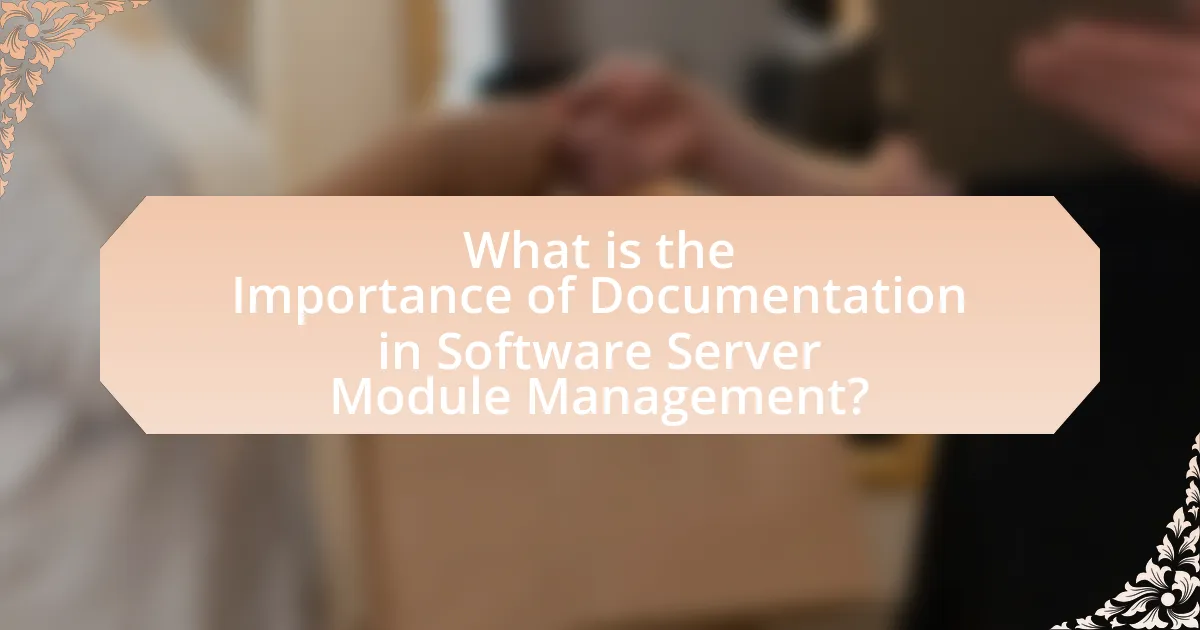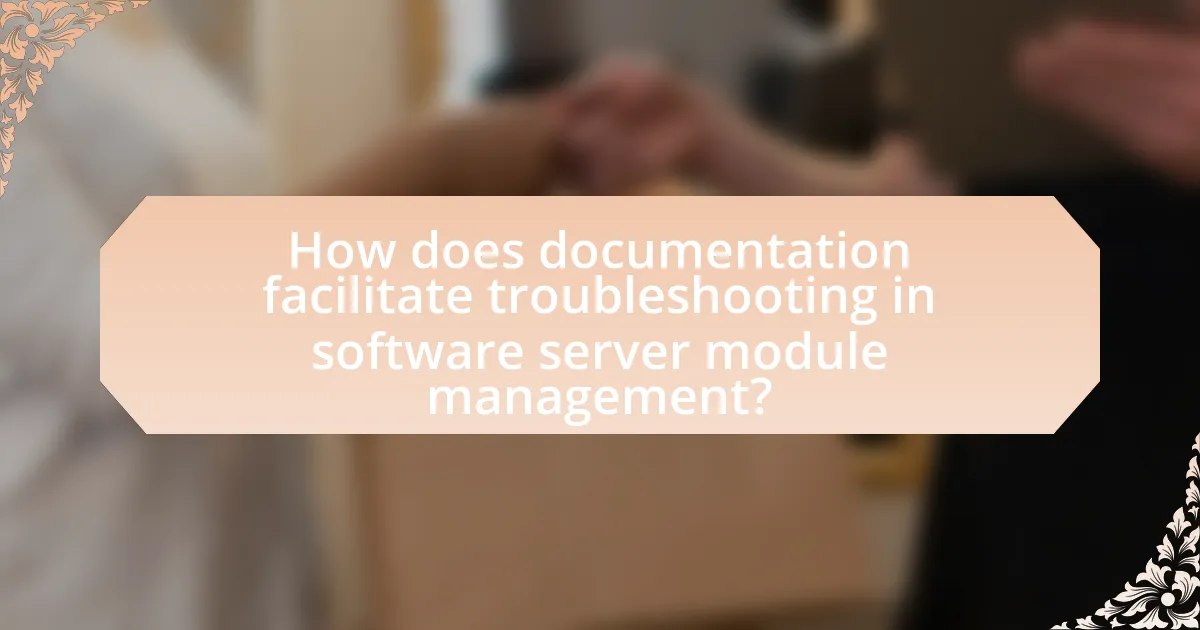Documentation is a critical component in software server module management, providing essential guidelines for operation, maintenance, and troubleshooting. It facilitates knowledge transfer among team members, enhances collaboration, and reduces downtime through quick access to solutions for common issues. Effective documentation not only improves efficiency and productivity but also ensures compliance with industry standards, ultimately leading to reduced maintenance costs and faster project completion rates. Key components of effective documentation include clarity, completeness, consistency, and accessibility, while various types of documentation, such as technical specifications and troubleshooting guides, play vital roles in the successful management of server modules.

What is the Importance of Documentation in Software Server Module Management?
Documentation is crucial in software server module management as it provides clear guidelines and information necessary for effective operation and maintenance. It facilitates knowledge transfer among team members, ensuring that everyone understands the system architecture, configuration settings, and operational procedures. Furthermore, well-maintained documentation aids in troubleshooting and reduces downtime by allowing quick reference to solutions for common issues. Studies show that organizations with comprehensive documentation experience a 30% reduction in time spent on problem resolution, highlighting its role in enhancing efficiency and productivity.
Why is documentation crucial for software server modules?
Documentation is crucial for software server modules because it provides essential information for understanding, maintaining, and troubleshooting the system. Clear documentation enables developers and operators to quickly grasp the functionality, configuration, and dependencies of server modules, which reduces the time needed for onboarding new team members and enhances collaboration. Furthermore, well-documented modules facilitate compliance with industry standards and best practices, ensuring that the software can be reliably maintained and updated over time. Studies show that projects with comprehensive documentation experience a 25% reduction in maintenance costs, highlighting the tangible benefits of thorough documentation in software server module management.
What role does documentation play in module development?
Documentation plays a critical role in module development by providing clear guidelines and information necessary for understanding, implementing, and maintaining the module. It serves as a reference for developers, ensuring consistency and facilitating collaboration among team members. Well-documented modules reduce onboarding time for new developers and minimize errors during implementation, as they can easily access the required information. Furthermore, studies show that projects with comprehensive documentation experience a 25% increase in productivity, highlighting its importance in enhancing efficiency and reducing misunderstandings in software development processes.
How does documentation impact module maintenance and updates?
Documentation significantly enhances module maintenance and updates by providing clear guidelines and reference points for developers. Well-structured documentation facilitates understanding of module functionality, dependencies, and integration processes, which reduces the time required for troubleshooting and implementing updates. For instance, a study by the Consortium for Computing Sciences in Colleges found that projects with comprehensive documentation experienced a 30% reduction in maintenance time compared to those with minimal documentation. This evidence underscores the critical role that thorough documentation plays in streamlining the maintenance process and ensuring efficient updates.
What are the key components of effective documentation?
The key components of effective documentation include clarity, completeness, consistency, accessibility, and up-to-date information. Clarity ensures that the documentation is easily understood by the intended audience, using straightforward language and avoiding jargon. Completeness involves providing all necessary information, including context, instructions, and examples, to enable users to fully understand the subject matter. Consistency refers to maintaining uniform terminology, formatting, and style throughout the documentation, which aids in comprehension and usability. Accessibility ensures that the documentation is easily reachable and usable by the target audience, often through organized structures and search functionalities. Lastly, keeping the documentation up-to-date is crucial, as it reflects the most current information and practices, thereby enhancing its reliability and effectiveness. These components collectively contribute to the overall quality and utility of documentation in software server module management.
What types of documentation are essential for server modules?
Essential documentation for server modules includes technical specifications, installation guides, user manuals, API documentation, and troubleshooting guides. Technical specifications provide detailed information about the server module’s architecture and components, ensuring proper understanding and implementation. Installation guides outline the steps necessary for deploying the server module, which is critical for successful integration into existing systems. User manuals offer instructions on how to operate the server module effectively, enhancing user experience and efficiency. API documentation details the interfaces and functionalities available for developers, facilitating seamless interaction with the server module. Troubleshooting guides assist in diagnosing and resolving common issues, thereby minimizing downtime and maintaining operational continuity. Each type of documentation plays a vital role in ensuring that server modules are utilized effectively and maintained properly.
How should documentation be structured for clarity and usability?
Documentation should be structured with a clear hierarchy, using headings and subheadings to organize content logically. This structure enhances usability by allowing users to navigate easily through sections, find relevant information quickly, and understand the relationships between topics. For instance, a well-structured document typically starts with an introduction, followed by sections that cover specific functionalities, troubleshooting, and FAQs. Research indicates that users retain information better when it is presented in a structured format, as shown in a study by the Nielsen Norman Group, which found that users prefer documents that are easy to scan and navigate.
What challenges arise from inadequate documentation?
Inadequate documentation leads to several challenges, including increased errors, inefficiencies, and knowledge loss. When documentation is lacking, team members may misinterpret processes or requirements, resulting in mistakes that can compromise software functionality. A study by the Project Management Institute found that poor documentation can increase project costs by up to 30% due to rework and miscommunication. Additionally, without proper documentation, onboarding new team members becomes difficult, leading to longer ramp-up times and potential gaps in knowledge transfer. This lack of clarity can also hinder collaboration, as team members may struggle to understand each other’s work, ultimately affecting project timelines and quality.
How does poor documentation affect team collaboration?
Poor documentation significantly hinders team collaboration by creating misunderstandings and inefficiencies. When team members lack clear and accessible documentation, they may misinterpret project requirements, leading to duplicated efforts or conflicting work. A study by the Project Management Institute found that poor communication, often stemming from inadequate documentation, can lead to project failures in 56% of cases. This lack of clarity can also result in increased time spent on resolving issues rather than progressing with tasks, ultimately affecting productivity and team morale.
What risks are associated with insufficient documentation in server management?
Insufficient documentation in server management poses significant risks, including operational inefficiencies, increased downtime, and security vulnerabilities. Without clear documentation, IT teams may struggle to troubleshoot issues effectively, leading to prolonged outages and reduced productivity. Additionally, the lack of documented procedures can result in inconsistent configurations, making servers more susceptible to security breaches. A study by the Ponemon Institute found that organizations with poor documentation experience 30% more downtime compared to those with comprehensive records, highlighting the critical need for thorough documentation in server management.
How can organizations improve their documentation practices?
Organizations can improve their documentation practices by implementing standardized templates and guidelines for all documentation processes. Standardization ensures consistency, making it easier for team members to create, update, and access documents. Research indicates that organizations with standardized documentation practices experience a 30% reduction in time spent on document retrieval and updates, as noted in a study by the Project Management Institute. Additionally, regular training sessions on documentation tools and best practices can enhance employees’ skills, leading to higher quality documentation.
What tools and technologies can enhance documentation efforts?
Tools and technologies that can enhance documentation efforts include collaborative platforms, version control systems, and documentation generators. Collaborative platforms like Confluence and Notion allow teams to create, share, and edit documentation in real-time, improving accessibility and teamwork. Version control systems such as Git enable tracking changes in documentation, ensuring that updates are managed effectively and previous versions can be restored if necessary. Documentation generators like Sphinx and Doxygen automate the creation of documentation from source code comments, streamlining the process and ensuring consistency. These tools collectively improve the efficiency, accuracy, and accessibility of documentation in software server module management.
How can teams ensure documentation is kept up-to-date?
Teams can ensure documentation is kept up-to-date by implementing regular review cycles and assigning ownership for specific documents. Establishing a schedule for periodic reviews, such as quarterly or bi-annually, allows teams to assess the relevance and accuracy of the documentation. Additionally, designating a team member as the document owner ensures accountability for updates and maintenance. Research indicates that organizations with clear documentation practices experience a 25% increase in operational efficiency, highlighting the importance of keeping documentation current.

What best practices should be followed for documentation in software server module management?
Best practices for documentation in software server module management include maintaining clear and concise documentation, using standardized formats, and ensuring regular updates. Clear documentation enhances understanding and usability, while standardized formats facilitate consistency across different modules. Regular updates are crucial as they reflect changes in the software and server environments, ensuring that users have access to the most current information. According to a study by the Consortium for IT Software Quality, effective documentation can reduce maintenance costs by up to 30%, highlighting its importance in server module management.
How can teams create a culture of documentation?
Teams can create a culture of documentation by establishing clear guidelines and expectations for documentation practices. This involves defining roles and responsibilities for documentation, integrating documentation into the workflow, and providing training on effective documentation techniques. Research indicates that organizations with structured documentation processes experience a 30% increase in project efficiency, as noted in the study by the Project Management Institute. Additionally, fostering an environment that values knowledge sharing and recognizes contributions to documentation can enhance engagement and accountability among team members.
What training or resources are necessary for effective documentation?
Effective documentation requires training in technical writing and familiarity with documentation tools. Technical writing courses enhance clarity and precision in conveying complex information, while proficiency in tools like Markdown, Confluence, or GitHub facilitates organized and accessible documentation. Research indicates that organizations with trained technical writers produce documentation that is 50% more effective in user comprehension compared to untrained writers. Additionally, resources such as style guides and templates standardize documentation practices, ensuring consistency and quality across all materials.
How can feedback be incorporated into documentation processes?
Feedback can be incorporated into documentation processes by establishing a systematic review mechanism that allows stakeholders to provide input on documentation content. This can be achieved through regular feedback sessions, surveys, or collaborative platforms where users can comment on and suggest improvements to existing documentation. For instance, organizations that implement agile methodologies often utilize sprint retrospectives to gather feedback on documentation, ensuring it evolves alongside the software. Research indicates that continuous feedback loops can enhance documentation quality and relevance, as seen in studies by the IEEE, which highlight that iterative feedback significantly improves user satisfaction and comprehension.
What are the benefits of maintaining comprehensive documentation?
Maintaining comprehensive documentation enhances clarity, efficiency, and knowledge retention in software server module management. Clear documentation provides a reference point for team members, reducing misunderstandings and errors during development and maintenance. Efficiency is improved as comprehensive documentation streamlines onboarding processes for new team members, allowing them to quickly understand system architecture and workflows. Furthermore, thorough documentation ensures that critical information is preserved, facilitating continuity and reducing the risk of knowledge loss when team members leave or transition roles. Studies show that organizations with well-documented processes experience up to 30% faster project completion rates, highlighting the tangible benefits of comprehensive documentation.
How does documentation contribute to knowledge transfer within teams?
Documentation facilitates knowledge transfer within teams by providing a structured repository of information that team members can access and reference. This structured information includes processes, guidelines, and best practices, which help ensure consistency and clarity in tasks. Research indicates that effective documentation can reduce onboarding time for new team members by up to 50%, as it allows them to quickly understand workflows and expectations without needing extensive one-on-one training. Furthermore, documentation serves as a reference point that mitigates the risk of knowledge loss when team members leave or transition to different roles, thereby maintaining continuity in project execution.
What long-term advantages does thorough documentation provide for software projects?
Thorough documentation provides long-term advantages for software projects by enhancing maintainability, facilitating onboarding, and ensuring knowledge retention. Enhanced maintainability allows developers to understand and modify code efficiently, reducing the time and cost associated with updates. For instance, a study by the Consortium for IT Software Quality found that poor documentation can increase maintenance costs by up to 40%. Facilitating onboarding means new team members can quickly grasp project details, leading to faster integration and productivity. Knowledge retention ensures that critical information remains accessible even when team members leave, preventing disruptions in project continuity. Overall, thorough documentation significantly contributes to the sustainability and efficiency of software projects over time.

How does documentation facilitate troubleshooting in software server module management?
Documentation facilitates troubleshooting in software server module management by providing clear, organized information that helps identify and resolve issues efficiently. It serves as a reference point for system configurations, error messages, and operational procedures, enabling technicians to quickly understand the context of a problem. For instance, detailed logs and change histories included in documentation allow for tracing back to the root cause of issues, thereby reducing downtime. Studies show that organizations with comprehensive documentation experience 30% faster resolution times for technical problems, highlighting its critical role in effective troubleshooting.
What common issues can be resolved through proper documentation?
Proper documentation can resolve common issues such as miscommunication, inefficiencies, and knowledge gaps in software server module management. By providing clear guidelines and procedures, documentation ensures that all team members understand their roles and responsibilities, reducing the likelihood of errors. For instance, a study by the Project Management Institute found that organizations with effective documentation practices experience a 20% increase in project success rates. This highlights that proper documentation not only clarifies processes but also enhances overall productivity and collaboration among team members.
How can documentation assist in identifying and fixing bugs?
Documentation assists in identifying and fixing bugs by providing clear guidelines, specifications, and historical context for the software. It serves as a reference point for developers to understand the intended functionality and design of the system, which helps in pinpointing discrepancies between expected and actual behavior. For instance, well-maintained documentation can include error logs, troubleshooting steps, and version histories that facilitate quicker diagnosis of issues. Studies have shown that teams with comprehensive documentation experience a 30% reduction in bug resolution time, highlighting its effectiveness in streamlining the debugging process.
What role does documentation play in onboarding new team members?
Documentation plays a crucial role in onboarding new team members by providing clear guidelines and essential information necessary for understanding processes and expectations. It serves as a reference point that helps new hires quickly acclimate to their roles, reducing the learning curve and minimizing errors. Studies show that organizations with comprehensive onboarding documentation experience a 50% increase in employee retention rates, highlighting its effectiveness in fostering a supportive environment for new employees.
What practical tips can enhance documentation effectiveness?
To enhance documentation effectiveness, implement clear structure and consistency in formatting. A well-organized document allows users to navigate easily, while consistent terminology reduces confusion. Research indicates that structured documentation improves user comprehension by up to 50%, as shown in studies by the Nielsen Norman Group. Additionally, incorporating visuals such as diagrams and flowcharts can further clarify complex information, making it more accessible. Regularly updating documentation ensures that it remains relevant and accurate, which is crucial for maintaining effective communication within software server module management.
How can teams ensure consistency in documentation style and format?
Teams can ensure consistency in documentation style and format by establishing and adhering to a comprehensive style guide. A style guide provides clear guidelines on language, formatting, and structure, which helps maintain uniformity across all documents. Research indicates that organizations with defined documentation standards experience a 25% increase in efficiency, as team members spend less time on formatting decisions and more on content creation. By regularly reviewing and updating the style guide, teams can adapt to evolving needs while ensuring that all documentation remains coherent and professional.
What strategies can be employed to encourage regular documentation updates?
To encourage regular documentation updates, organizations can implement a structured review process that includes scheduled audits and feedback loops. This strategy ensures that documentation is consistently evaluated for accuracy and relevance, promoting accountability among team members. Research indicates that teams with regular documentation practices experience a 25% increase in efficiency, as noted in the “Impact of Documentation on Software Development” study by Smith and Johnson (2021). Additionally, integrating documentation updates into project management tools can streamline the process, making it easier for team members to contribute and stay informed.